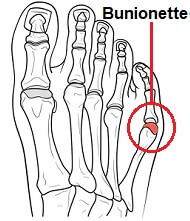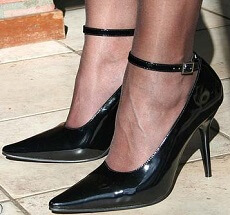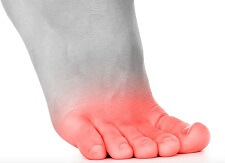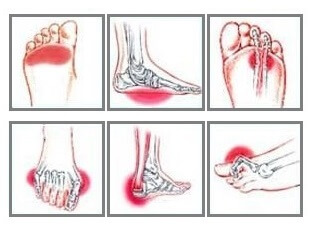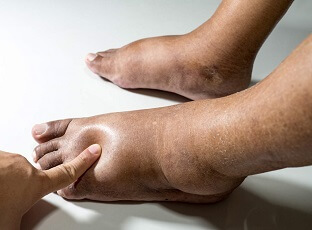- Home
- Common Foot Problems
- Bunions
Foot Bunion
Written By: Chloe Wilson BSc(Hons) Physiotherapy
Reviewed By: FPE Medical Review Board
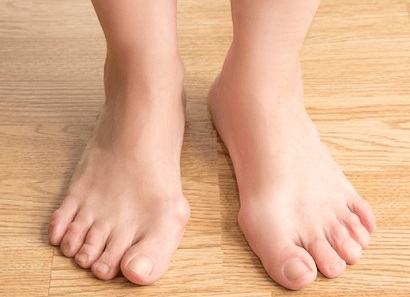
A foot bunion is a common cause of pain caused by deformity of one of the toe bones.
Foot bunions present as a large bump on the outer side of the big toe that is red, swollen and painful caused by the toe deviating across towards the second toe.
Bunions most commonly affects the big toe, known as hallux abducto valgus, but can also affect the little toe, known as a bunionette.
Left untreated, bunions usually get gradually worse causing increasing inner foot pain, so it is important to get treatment early on else you may end up needing surgery.
Here we will find an overview of the common causes and symptoms of foot bunions, the best treatment options including surgery and how to prevent them from developing in the first place or coming back in the future.
What Is A Foot Bunion?
A foot bunion is where the big toe gradually deviates inwards towards the second toe and in severe cases may even start to cross over the top or underneath. As the top of the toe moves inwards, the base of the toe (the knuckle part), pushes outwards producing the characteristic lump on outer side of the big toe.
The medical term for a foot bunion at the big toe is a hallux abducto valgus, or hallux valgus. “Hallux” means big toe, “abducto” means to move away from the midline and “valgus” refers to the abnormal angle of the toe.
Bunions can also occur in the little toe, where they are known as a bunionette or tailors bunion, but these are much less common.
There are a couple of problems that can develop alongside bunions. Firstly, the sesamoid bones (two small pea-shaped bones) that sit under the base of the big toe can get shifted out of place. They may then become inflamed, known as sesamoiditis.
Secondly, if the bursa (small fluid filled sac) that sits over the big toe gets irritated it may become inflamed, known as bursitis.
What Causes Foot Bunions?
There is some debate about the main causes of foot bunions, but they tend to fall into two categories:
1. Genetics
There is a definite genetic link with bunions, meaning that if someone in your family suffers from a hallux abducto valgus, there is a high chance that you will too. It may be due to an abnormal foot position such as flat feet, or a medical condition such as hypermobility (where your joints are overly flexible) or arthritis (e.g. rheumatoid arthritis or gout).
2. Ill-Fitting Footwear
Poorly fitting shoes are thought to be the other common cause of foot bunion. Frequently wearing tight fitting shoes, especially shoes with pointed toes or high heels places excessive pressure on the big toe squashing it into the classic hallux abducto valgus position.
There is much debate as to which is the major cause of bunions, but it is likely to be a combination of the two. Studies have shown that in cultures where people don’t wear shoes but are habitually barefoot, there are very few cases of foot bunions indicating a strong correlation with shoe wear. Bunions are more common in females, most likely due to choice of footwear.
Painful bunions are more common with increasing age. They develop gradually overtime from repeated force through the big toe and left untreated, become more pronounced with worsening symptoms.
Foot Bunion Symptoms
The most classic symptoms of a foot bunion are:
- Hard Lump: The first symptom of a foot bunion is typically the formation of a hard lump on the side of the toe
- Redness: The skin over the bunion often becomes red and inflamed as it rubs on footwear
- Toe Deviation: this is where the tip of the big toe starts to shift towards the second toe. This will develop gradually and progressively, rather than coming on suddenly and the big toe may end up crossed right over the second toe
- Toe Pain: At first, there may not be any discomfort associated with a foot bunion, but as it gets more pronounced, toe pain often develops
- Stiffness: Toe movement gets more restricted as a foot bunion develops
You can find out loads more about these and other possible bunion symptoms, including they progress, in the foot bunion symptoms section.
How Do You Treat An Inflamed Bunion?
There are a number of different foot bunion treatment options which can be split into two groups:
1. Non-Surgical Treatment
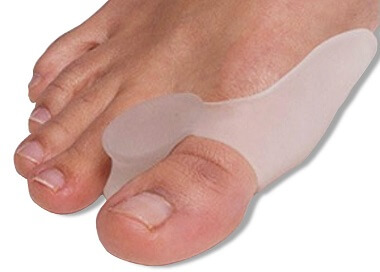
Foot bunion treatment aims to reduce the pain, prevent foot bunions from becoming worse and avoid the need for surgery.
Changing your footwear is the best place to start if you have a bunion. Medication and ice can help to reduce the pain and inflammation associated with the condition.
Another thing that can really help is orthotics - specially designed splints, such as the bunion protector shown here, to help to hold your toe in the correct position to help stop it from deviating out to the side.
You can find out all about these different treatment options and more in the Bunions Treatment section. The sooner you start these treatment methods, the more your
symptoms will reduce and the more likely you'll be able to avoid surgery.
2. Surgical Treatment
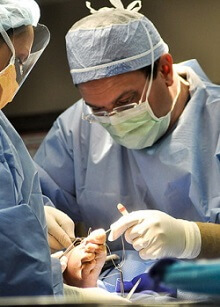
If non-surgical foot bunion treatments are not working and your painful bunions are affecting your day-to-day activities, you may need to have surgery to correct the hallux abducto valgus.
There are a number of different types of bunion surgery, but the two most common are:
- Osteotomy: where part of the bone is removed to realign the toes
- Fusion: where the joint at the bottom of the toe is fused - this is usually only done for more severe cases
It usually takes about six to eight weeks to recover from surgery, although swelling may persist for six months, and they have a success rate of approximately 85%.
You can find out lots more about the different types of surgery, how they are performed and the recovery process in the Bunion Surgery section.
Prevention Strategies
The simplest way to reduce your chance of developing foot bunion or bunionette problems is to wear good-fitting shoes. Avoid high heels as they push your feet forwards to the front of the shoe where they get squashed.
Also avoid narrow fitting shoes, especially those that are pointed at the front with a narrow toe box as again, these place pressure through the toes pushing them inwards. Shoes should be comfortable and leave enough room for you to wiggle your toes. Remember, they rarely affect non-shoe wearing people.
Exercising your feet can also help. By strengthening the foot muscles you can improve your foot position which can help reduce foot bunion problems. Simple exercises like picking up small objects with your toes can help – visit the foot exercises section for more information.
What Else Can Help?
You can find out loads more about bunions in the following sections:
- Bunion Symptoms: Includes both classic and less common symptoms
- Treatment Options: Best treatments including orthotics and exercises
- Surgery: Different surgical options available
- Recovering from Surgery: Recovery guide for after bunion surgery
- Top Products: Things that can help with prevention or recovery from surgery
Whilst a foot bunion or bunionette is one of the most common causes of toe pain, if this is not sounding quite like your problem, visit the Toe Pain section. If you want some help working out what is causing your pain, visit the Foot Pain Diagnosis section.
You may also be interested in the following articles:
- Pain On Top Of Foot
- Ball Of Foot Pain
- Pain On Bottom Of Foot
- Inner Foot Pain
- Outer Foot Pain
- Nerve Pain In The Foot
- Foot & Ankle Stretches
- Foot Numbness
- Foot Lumps & Bumps
Page Last Updated: 11/14/23
Next Review Due: 11/14/25
